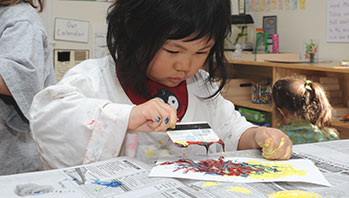- brown tissue paper
- hair dryer (optional)
- large sheet of chart (mural) paper
- large sheets of drawing paper
- markers, crayons, and pencils
- pictures and books of plants at different stages of growth (including roots, bulb, stem, sprouts, flowers, etc.)
- paint brushes
- scissors
- small container or tray filled with watered-down glue
- tempera paint
- leaves
- root
- seed
- soil
- sprout
MA Standards:
Speaking and Listening/SL.PK.MA.5: Create representations of experiences or stories (e.g., drawings, constructions with blocks or other materials, clay models) and explain them to others.
Writing/W.PK.MA.2:Use a combination of dictating and drawing to explain information about a topic.
MA Draft STE Standards:
Life Sciences/From Molecules to Organisms: Inheritance and Variation of Traits/LS1/3.A: Describe/draw and compare the body parts of animals (including themselves) and plants they are investigating [System] and explain functions of some of the observable body parts. [Structure and Function]
Head Start Outcomes:
Literacy Knowledge/Early Writing: Experiments with writing tools and materials.
Literacy Knowledge/Early Writing: Uses scribbles, shapes, pictures, and letters to represent objects, stories, experiences, or ideas.
PreK Learning Guidelines:
English Language Arts/Composition 16: Use their own words or illustrations to describe their experiences, tell imaginative stories, or communicate information about a topic of interest.
Outdoor Plant Mural

© Commonwealth of Massachusetts, Department of Early Education and Care (Jennifer Waddell photographer). All rights reserved.
Skill Focus: Creative Expression, Fine Motor Skills, Vocabulary
Have children work together to create a mural of plants that grow outside—in their neighborhood, around their school, at home, etc. Draw a horizontal line across the middle of a large sheet of mural paper.
- Point as you tell children that the area below the line is the soil or dirt. Have children rip sheets of brown tissue paper or construction paper and help them paste the “soil” below the line on the mural.
- Then have children add seeds, roots, pebbles, worms, etc., in the soil. Encourage them to look at the pictures and books on display for ideas.
- Have each child make big strokes with paint on top of above the dirt to make big plants (e.g., carrots, flowers, herbs). Allow paint to dry or use a hair dryer to dry the plants.
- Then have children draw plant sprouts, stems, grass, etc., above the soil. Prompt children to use the focal vocabulary to describe their murals. (“This part is the soil; this part is the roots.” “The seed grew into a big orange carrot!”)
